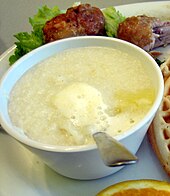Grits
 | |
| Type | Porridge |
|---|---|
| Place of origin | United States |
| Main ingredients | Ground corn |
| Variations |
|

Grits are a type of porridge made from coarsely ground dried maize[clarification needed] or hominy,[1] the latter being maize that has been treated with an alkali in a process called nixtamalization, with the pericarp (ovary wall) removed. Grits are cooked in warm salted water or milk. They are often served with flavorings[2] as a breakfast dish. Grits can be savory or sweet, with savory seasonings being more common. Grits are similar to other thick maize-based porridges from around the world, such as polenta and mieliepap. The dish originated in the Southern United States but is now available nationwide. Grits are often part of a dinner entrée shrimp and grits, served primarily in the Southern United States.[2]
The word "grits" is derived from the Old English word grytt, meaning "coarse meal".[3] In the Charleston, South Carolina area, cooked hominy grits were primarily referred to as "hominy" until the 1980s.[4][5]
Origin
[edit]The dish originated with the Native American Muscogee tribe using maize.[6] American colonists learned to make the dish from the Native Americans, and it quickly became an American staple.[7]
At that time, maize or hominy for grits was ground on a stone mill. The ground material was passed through screens, the finer sifted material used as grit meal, and the coarser as grits.[8]
Three-quarters of the grits sold in the U.S. are bought in the South, in an area stretching from Lower Texas to Washington, D.C., that is sometimes called the "grits belt".[9] The state of Georgia declared grits to be its official prepared food in 2002.[10] A similar bill was introduced in South Carolina to name it the official state food,[11] but it did not advance.[12] Nevertheless, South Carolina still has an entire chapter of legislation dealing exclusively with corn meal and grits.[13] State law in South Carolina requires grits and rice meal to be enriched, similar to the requirement for flour.[13]
Grits may be either yellow or white, depending on the color of the maize used. The most common version in supermarkets is "quick" grits, which are made from non-hominy maize and have the germ and hull removed. Whole kernel grits are sometimes called "speckled".[14]
Preparation
[edit]
Grits are prepared by mixing water or milk and the dry grits and stirring them over heat, if one uses cornmeal, the food is called mush.[15][16] Whole grain grits require much longer to become soft than "quick grits".
Dishes
[edit]
Grits are eaten with a wide variety of foods, such as eggs and bacon, fried catfish, shrimp, salmon croquettes, or country ham.[17]
Shrimp and grits is a traditional dish in the coastal communities in the South Carolina Lowcountry and Georgia's Lower Coastal Plain.[18]
Solidified cooked grits can be sliced and fried in vegetable oil, butter, or bacon grease to make fried grits, or they can first be breaded in beaten egg and bread crumbs.[19]
See also
[edit]- Creamed corn
- Cuisine of the Southern United States
- Cuisine of the United States
- Farina (food)
- Groats
- Hasty pudding
- List of porridges
- Mush (cornmeal)
- Polenta
- Three Sisters (agriculture)
References
[edit]- ^ "Food Buying Guide for Child Nutrition Programs: Chapter 4 Grains" (PDF). Retrieved November 23, 2023.
- ^ a b Moss, Robert. "The Surprisingly Recent Story of How Shrimp and Grits Won Over the South". Serious Eats. Retrieved March 21, 2017.
- ^ Harper, Douglas. "grits". Online Etymology Dictionary. Retrieved August 27, 2011.
- ^ Lee, Matt; Lee, Ted. "Iconic Southern Plates: Lowcountry Shrimp and Grits". Southern Living. Retrieved September 3, 2022.
- ^ Huguenin, Mary Vereen; Stoney, Anne Montague, eds. (1950). Charleston Receipts. Junior League of Charleston. p. 153.
- ^ "Shrimp and Grits: A History". Deep South Magazine. Deep South Media, LLC. October 1, 2014. Archived from the original on March 7, 2016. Retrieved September 20, 2018.
- ^ Wulff, Alexia (November 7, 2016). "A Brief History Of Grits". Culture Trip. Retrieved July 31, 2021.
- ^ Marcus, Erica (May 3, 2006). "Burning Questions: Kernels of Truth on Ground Corn". Newsday. Melville, New York: Knight Ridder Tribune Business News. p. 1 – via ProQuest.
- ^ Cutler, Charles L. (2002). Tracks that Speak: The Legacy of Native American Words in North American Culture. Boston: Houghton Mifflin. p. 28. ISBN 0-618-06510-5.
- ^ "State Prepared Food". sos.georgia.gov. Georgia Secretary of State. Archived from the original on August 29, 2008. Retrieved December 14, 2007.
- ^ "South Carolina General Assembly 113th Session, 1999–2000, Bill Number: 4806". scstatehouse.gov. South Carolina Legislature. Retrieved February 12, 2017.
- ^ "A Bill And the Code of Laws of South Carolina, 1976, By Adding Section 1-1-703 So As To Recognize Grits As the Official Food of the State. Session 113 - (1999-2000). 4806 General Bill, By Altman". scstatehouse.gov. South Carolina Legislature. Retrieved June 22, 2019.
- ^ a b "Code of Laws. Title 39. Trade and Commerce. Chapter 29. "Corn Meal and Grits"". scstatehouse.gov. South Carolina Legislature. Retrieved July 8, 2022.
- ^ Lee, Matt; Lee, Ted (April 26, 2000). "A Taste of Charleston; Corn's Highest Calling: Grits". The New York Times. Retrieved March 17, 2018.
- ^ "How to Make Grits". Better Homes and Gardens. Retrieved February 10, 2020 – via bhg.com.
- ^ "Cornmeal vs. Grits vs. Polenta". The Spruce Eats. Retrieved February 10, 2020.
- ^ "How To Cook Grits Like A Southerner". HuffPost. October 29, 2014. Retrieved February 10, 2020.
- ^ Moss, Robert (May 13, 2020). "The Surprisingly Recent Story of How Shrimp and Grits Won Over the South". seriouseats.com. Retrieved March 15, 2022.
- ^ Stacey, Leah. "Southern Fried Grit Patties". justapinch.com. Just A Pinch Recipe Club. Retrieved March 15, 2022.
